ASUS Zenbook (UX21) Review
by Anand Lal Shimpi on October 22, 2011 8:00 PM ESTThe Display
To hit a $999 price point with the hardware that it has, ASUS (like Apple) had to give up the pursuit of an IPS panel in the Zenbook. As we saw with the MacBook Air however, it is quite possible to select a decent TN panel at this price point. Was ASUS able to? Sort of.
In the interest of beating Apple, ASUS pursued a brighter overall display design. ASUS even selected a new optical film for the Zenbook's panel that helps improve brightness. As a result, the Zenbook UX21 is brighter than the 11-inch MBA. Given the sad state of most PC notebook displays, the Zenbook fares very well when compared to its PC brethren as well. Very few PC displays are as bright as what we saw with the Zenbook. In fact, a quick look at our PC notebook Bench database reveals the Zenbook is the brightest PC notebook we've ever tested.
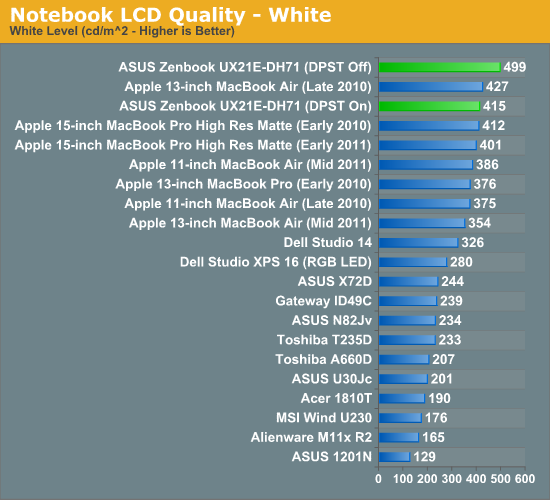
The brightness does come with a downside: higher than desirable black levels. The lowest black level I measured on the UX21 was 1.1 nits using our X-rite i1Display 2, however in the center of the display I measured 1.20 nits. This is nearly double the value I recorded on the 11-inch MacBook Air. Although not terrible, the black levels on the Zenbook's panel could use some improvement. Note that these results were generated with Intel's DPST (Display Power Savings Technology) enabled. Without DPST enabled, the black levels jump even higher to 2.7 nits in our test, while the white point makes it to just under 500 nits. Contrast ratio actually goes down since the impact on black levels is greater than the increase in white point brightness. ASUS ties DPST state to power mode; it's enabled in High Performance mode (on AC power) but disabled in Battery Saver mode (on DC power). You can override these settings by manually configuring the power plan in the Windows 7 control panel.
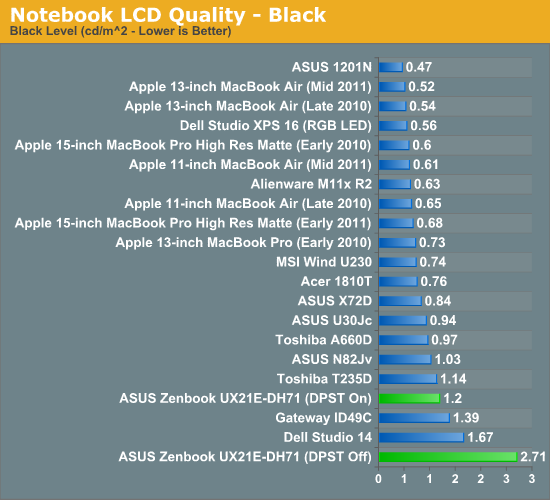

ASUS sent along test data that showed its black levels were only around 40% higher than the 11-inch MBA; however, after a couple of nights of trying I couldn't get any better than the numbers I've presented here. ASUS does use a more sophisticated colorimeter, but its test data for the MacBook Air seems to match up with mine whereas its Zenbook data is considerably better than what I have here.

ASUS' Display Test Data
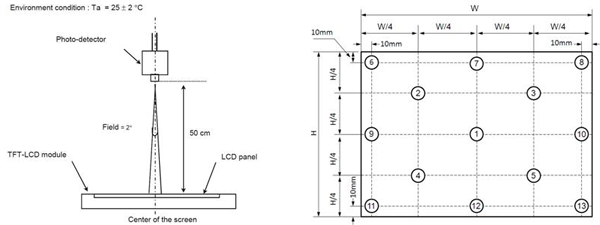
It's possible I simply received a bad unit, or perhaps I just lost the panel lottery with the UX21, but I can only report on the data I was able to generate. The Zenbook UX21's display is very bright, but it neeeds better black levels.
In terms of color quality and gamut, the Zenbook is very competitive once calibrated. You get better color gamut than a MacBook Air and comparable color accuracy. However, the out of the box calibration isn't all that great, as ASUS doesn't calibrate white to 6500K at the factory (it's set to 7700K by default). The system does ship with a digital color management system called Splendid, but you don't have many options beyond moving RGB or color temperature sliders. If ASUS wants to compete in this space I do believe it needs to calibrate panels at the factory.
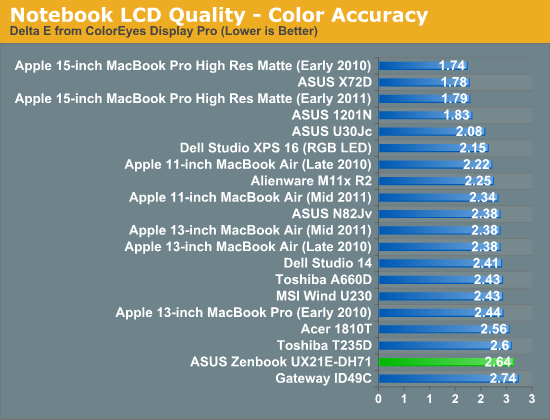
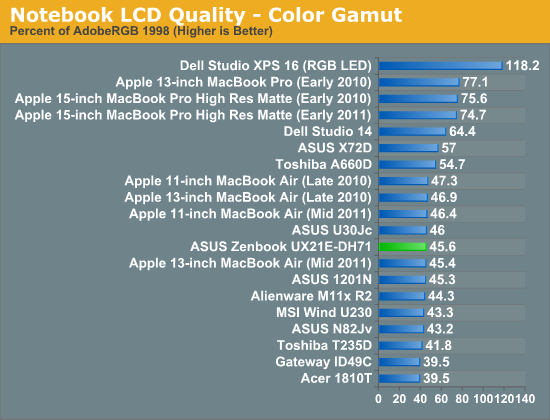
Viewing angle is my only other complaint about the UX21's panel. It seems as if in the quest for better specs, ASUS didn't pay enough attention to viewing angles. Although the UX21 uses a TN panel it is possible to improve viewing angle through the use of a compensation film in front of the polarizer in the display stack. Most TN panels are paired with some form of wide viewing angle film to improve their characteristics, but Apple actually uses an extra wide view compensation film in the case of the MacBook Air to give it slightly more IPS-like viewing angles. The downside to using this film is it reduces light output, which in turn improves black levels (peak contrast ratio is generally unaffected since you clip both white and black levels).
ASUS opted against using the same EWV film as Apple, in part to improve overall brightness as well as guarantee a little bit of off-angle privacy. While the result is a brighter display than what Apple was able to accomplish, the UX21 is far more sensitive to viewing angles. As you can see in the shots below, the UX21 looks great straight on but anything off center is significantly worse. In most situations I didn't find this to be a huge problem as I was able to tilt the display a little farther back and prevent the display from getting too washed out.
Overall the display is better than the vast majority of what you find on PC notebooks, however a couple of key decisions kept ASUS from making it perfect. I have already fed my test data and suggestions back to ASUS engineering, who are currently evaluating options for the second generation UX series next year.
















109 Comments
View All Comments
CallumS - Saturday, October 22, 2011 - link
Looks like a brilliant design and in my opinion has better aesthetics than the MBA. What I would really like to see though is Thunderbolt or a decent alternative introduced across the line.Personally for basic web and coding I find ultra-portables perfectly capable at the task, especially with SSDs. However I would still like the option to plug in a maximum of two cables to get >FHD resolutions and everything else connected. I truly believe that including Thunderbolt was a brilliant idea for Apple. It really did open up a lot of opportunities.
BTW: Never owned a Mac and can't use OSX due to work applications. Looking for the best Windows alternative or to purchase a MBA to run Windows 7. The best alternative at the moment that I am aware of being a Thinkpad x220/x1/T420s with SSDs and docking station.
kaiedmek - Saturday, October 22, 2011 - link
A brilliant design!!! Come on, They just stole MBA design.... they didn't work on there own design, wished they did, but instead they just copied others design.To produce brilliant computer they should do their own design, so they can match the internal hardware with the design and of course the software performance.
CallumS - Sunday, October 23, 2011 - link
I never said an original design. =)I do agree though, it does look far too much like the MBA. Probably more so than the Samsung 10.1 tablet and the iPad; Which was banned here in Australia.
However there are key differences and as my post was pointing out, I believe these are to the advantage of the of the MBA; apart from aesthetics.
I think it would also be naive to suggest that the MBA was a completely original design also. There were many other notebooks with similar shapes and ambitions. Apple did however put them together very nicely though. I certainly do respect Apple's ability to accomplish such tasks.
Unfortunately not very helpful when most business applications are purely designed for the Windows environment at present. Hopefully in time we can see that change and some better innovation from Microsoft too. Windows 7 has certainly set a great foundation and Windows 8 is looking promising.
GeorgeH - Sunday, October 23, 2011 - link
Yep, without Thunderbolt and a docking station that allows more connectivity and the ability to attach a real (and hopefully upgradeable) GPU I'm just not interested. Otherwise this is just a slightly more useful tablet - an expensive niche within a niche.So here's hoping that the Ivy Bridge refresh brings a better screen, Thunderbolt, and a reasonably priced (I'm looking at you, Sony) external and upgradeable GPU.
DanNeely - Sunday, October 23, 2011 - link
It's the battery life that really disappoints me. I'd like something with more performance than my netbook; but my 1st gen models 6 hour battery never lasted me a full day at a convention.Roland00Address - Sunday, October 23, 2011 - link
I dislike the term "cells" for laptop batteries for it doesn't really tell you the capacity of the battery like the term Whr does.A 6 cell battery for a laptop would usually have a 40 Whr to 60Whr. This laptop has a 35Whr battery.
4 to 5 hours is pretty good for a 4 cell battery that is not running something dirt slow like atom
DanNeely - Sunday, October 23, 2011 - link
the runtime isn't unreasonable for the CPU+battery combination; but it's well short of what I'd need to be able to retire my netbook for something a bit speedier.netmann - Saturday, October 22, 2011 - link
Thanks for the great review as usual. Is there a chance the future update to this review would include performance comparison of Asus UX21 with 11-inch MacBook Air with Windows 7 (through Boot Camp) and OWC 6 GB/s SSD installed in it? I believe some of like the Apple hardware better than PC but prefer running Windows OS.vol7ron - Saturday, October 22, 2011 - link
Great review, two things:1) I wouldn't trust ASUS testing - thinking back to how horrible it is to contact their support, and how they had issues with their mobo's for the C2D (and so many other things)
2) It looks like the Skype images are on OSX, not Win7 :)
digitheatre - Monday, October 24, 2011 - link
It is because they want to test the UX21's video camera quality, so the screenshot is captured from MBA :P